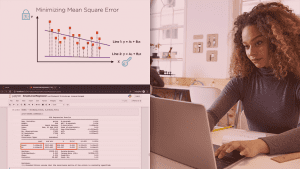By Janani Ravi
Course info


Description
Data science and data modeling are fast emerging as crucial capabilities that every enterprise and every technologist must possess these days. Increasingly, different organizations are using the same models and modeling tools, so what differs is how those models are applied to the data. Today, more than ever, it is really important that you know your data well. In this course, Interpreting Data using Statistical Models with Python you will gain the ability to go one step beyond visualizations and basic descriptive statistics, by harnessing the power of inferential statistics. First, you will learn how hypothesis testing, which is the foundation of inferential statistics, helps posit and test assumptions about data. Next, you will discover how the classic t-test can be used in a variety of common scenarios around estimating means. You will also learn about related tests such as the Z-test, Pearson’s Chi-squared test, Levene’s test and Welch’s t-test for dealing with populations that have unequal variances. Finally, you will round out your knowledge by using ANOVA, a powerful statistical technique used to measure statistical properties across different categories of data. When you’re finished with this course, you will have the skills and knowledge to use powerful techniques from hypothesis testing, including t-tests, ANOVA and regression tests in order to measure the strength of statistical relationships within your data.
About the author
Janani Ravi
A problem solver at heart, Janani has a Masters degree from Stanford and worked for 7+ years at Google. She was one of the original engineers on Google Docs and holds 4 patents for its real-time collaborative editing framework.
Course Overview
Hi, my name is Janani Ravi, and welcome to this course on Interpreting Data Using Statistical Models with Python. A little about myself, I have a master’s degree in electrical engineering from Stanford, and have worked at companies such as Microsoft, Google, and Flipkart. At Google, I was one of the first engineers working on real-time collaborative editing in Google Docs and I hold four patents for its underlying technologies. I currently work on my own startup, Loonycorn, a studio for high-quality video content. Data science and data modeling are fast emerging as crucial capabilities that every enterprise and every technologist must possess these days. Increasingly, different organizations are using the same models and modeling tools, so what differs is how these models are applied to the data. Today more than ever, it’s really important that you know your data well. In this course, you will gain the ability to go one step beyond visualizations and basic descriptive statistics by harnessing the power of inferential statistics. First, you will learn how hypothesis testing, which is the foundation of inferential statistics, helps posit and test assumptions about data. Next you will discover how the classic T-test can be used in a variety of common scenarios around estimating means. You will also learn about related tests such as the Z-test, Pearson’s chi-squared test, Levene’s test, and Welch’s t-test for dealing with populations that have unequal variances. Finally, you’ll round out your knowledge by using ANOVA, a powerful statistical technique used to measure statistical properties across different categories of data. When you’re finished with this course, you will have the skills and knowledge to use powerful techniques from hypothesis testing including T-tests, ANOVA, and regression tests in order to measure the strength of statistical relationships within your data.
Size: 416MB
https://www.pluralsight.com/courses/interpreting-data-using-statistical-models-python


